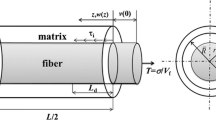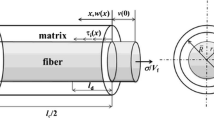Abstract
A three-dimensional analytical model based on the principle of minimum potential energy is developed and applied to determine the stress state in a discrete fiber/matrix composite cylinder subjected to axial tensile loading in the fiber direction and containing a non-axisymmetric transverse matrix crack and an interface debond. The friction over the debonded interface is incorporated into the analysis. The strain energy release rates associated with the matrix crack and the interface debonding under the combination of the applied load and the interface frictional force are computed. The strain energy release rate criterion has been employed to evaluate the critical applied loads for the two fracture modes and to assess the competition between propagation of a matrix crack and growth of interface debonding. A parametric study has been carried out. The computed results show that the interface friction plays an important role in the failure of brittle matrix composites.
Similar content being viewed by others
References
Aveston, J., Cooper, G. A. and Kelly, A., 'Single and Multiple Fracture', in The Properties of Fiber Composites Conference Proceedings, National Physical Laboratory, Teddington, U.K.IPC Science and Technology Press, Surrey, 1971, p. 15.
Aveston, J., 'Strength and Toughness of Fiber-Reinforced Ceramic', in The Properties of Fiber Composites Conference Proceedings, National Physical Laboratory, Teddington, U.K. IPC Science and Technology Press, Surrey, 1971, p. 16.
Aveston, J. and Kelly, A., 'Theory of Multiple Fracture of Fibrous Composites', J. Mater. Sci. 8, 1973, 352.
Marshall, D. B., Cox, B. N. and Evans, A. G., 'The Mechanics of Matrix Cracking in Brittle-Matrix Fiber Composites', Acta Metall. 33, 1985, 2013.
McCartney, L. N., 'Mechanics of Matrix Cracking in Brittle-Reinforced Composites', J. Roy. Soc. London A 409, 1987, 329.
Budiansky, B., Hutchinson, J. W. and Evans, A. G., 'Matrix Fracture in Fiber Reinforced Ceramics', J. Mech. Phys. Solids 34, 1987, 16.
Cox, H. L., 'The Elasticity and Strength Paper and Other Fibrous Materials', British J. Appl. Phys. 3, 1952, 72.
Hutchinson, J. W. and Jensen, H. M., 'Models of Fiber Debonding and Pull-out in Brittle Composites with Friction', Mech. Mater. 9, 1990, 139.
Kurtz, R. D. and Pagano, N. J., 'Analysis of the Deformation of a Symmetrically Loaded Fiber Embedded in a Matrix Material', Composites Engineering 1, 1991, 13.
Venkatakrishaiah, S. and Dharani, L. R., 'Analysis of an Axisymmetric Matrix Crack in a Single Fiber Composite', Eur. J. Mech., A/Solids 12, 1993, 567.
Kaw, A. K., Kunchithapatham, S. and Pagano, N. J., 'The Stress Field in a Cracked Brittle Matrix Composite Cylinder with a Frictional Interface', Int. J. Solids Structures 32, 1995, 2127.
Dharani, L. R., Chai, L. and Pagano, N. J., 'Steady State Cracking in Ceramic Matrix Composites', Comp. Sci. Technol. 39, 1990, 29.
Jones, W. F., On the Accuracy of Higher Order Shear Lag Model, Engineering Science Reprint ESP22/85046, Society of Engineering Science, 1985.
Popejoy, D. B. and Dharani, L. R., 'Effect of Fiber Coating and Interfacial Debonding on Crack Growth in Fiber-Reinforced Composites', Theoret. Appl. Fracture Mech. 18, 1992, 73.
Botsis, J., Zhao, D. and Beldica, C., 'Strength and Fracture of Composites with Well Aligned Fibers', in Failure Mechanics in Advanced Polymeric Composites, ASME AMD, Vol. 196, 1994.
Zhao, J. H. and Ji, F. S., 'Stress Analysis of Unidirectional Composites with a Surface Notch by Variational Principle', Engrg. Fract. Mech. 37, 1990, 727.
Dharani, L. R. and Ji, F. S., 'Non-Axisymmetric Matrix Cracking in Unidirectional Brittle Matrix Composites', Engrg. Fract. Mech. 53, 1996, 57.
Ji, F. S. and Dharani, L. R., 'Non-Axisymmetric Matrix Cracking and Interface Debonding in Unidirectional Brittle Matrix Composites', Eur. J. Mech., A/Solids 17, 1998, 253.
Lawrence, P., 'Some Theoretical Considerations of Fibre Pull-Out from an Elastic Matrix', J. Mater. Sci. 7, 1972, 1.
Author information
Authors and Affiliations
Rights and permissions
About this article
Cite this article
Ji, F.S., Dharani, L.R. Non-Axisymmetric Matrix Cracking and Interface Debonding with Friction in Ceramic Composites. Applied Composite Materials 5, 379–397 (1998). https://doi.org/10.1023/A:1008820315282
Issue Date:
DOI: https://doi.org/10.1023/A:1008820315282




